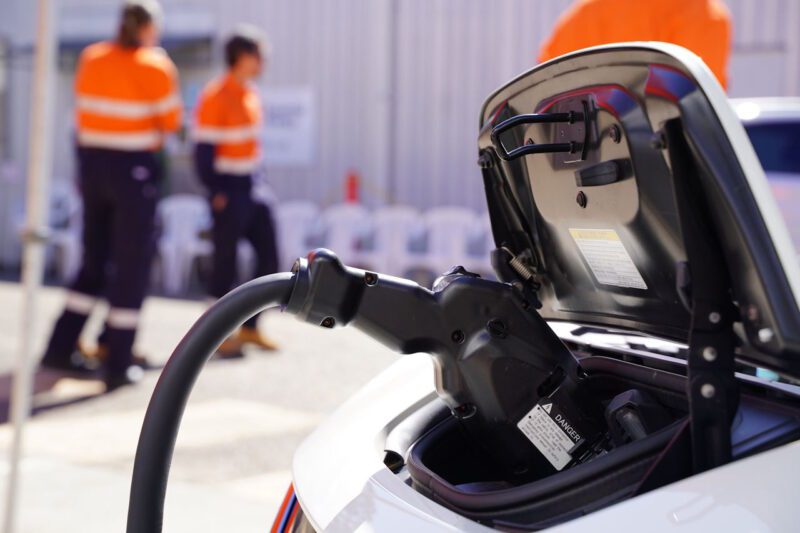In the past few years, home battery installations have gone from being a niche investment for prosumers to a mainstream household upgrade thanks to the turbocharge from the Cheaper Home Batteries scheme. With around 1,000 new home batteries installed each day, Australian installers have likened this to the early rooftop solar boom.
Fortunately for Distribution Network Service Providers (DNSPs), demand for Vehicle-to-Grid (V2G) electric vehicles hasn’t yet reached the same pace.
But if ARENA’s forecast of 300,000 bi-directional V2G EVs becomes reality by 2030, we’ll need a plan. These “batteries on wheels” can store and discharge up to five times the capacity of a typical home battery, and their operational patterns are not the same as standard EVs.
An export peak for 300,000 EVs all discharging at the same time would deliver around 2,200 MW – the equivalent of two large coal-fired power units suddenly flooding the grid in the evening. This could be far more disruptive than the rush of home batteries being installed today and planning must start now.
EV growth outpacing the grid
EVs now make up more than 12% of new car sales in Australia and the growth of EVs and demand for vehicles that are capable of bi-directional charging is coming. DNSPs who have spent the past decade shaping rules around new solar and home battery connections have now directed their attention towards V2G technologies.
This is supported by evidence from a multi-year study by the National Grid on Electric Nation Powered Up that explores how V2G charging affects low-voltage networks.
One key finding was that “the concept of a typical load profile for a charger or home was no longer fit for purpose”. The study found V2G users tended to discharge their vehicles in the evening to meet household demand, then recharge their vehicles overnight. This led to a higher overnight grid demand than with conventional EVs.
Instead of the traditional evening consumption peak, V2G could create evening export peaks as users send power back to the grid during high-tariff periods. Without substation or feeder-level visibility, DNSPs could be blind to these patterns, unable to calculate hosting capacity or anticipate constraints.
Why network visibility matters
Real-time monitoring and advanced modelling of low-voltage networks will be critical if Australia is to transition towards the large-scale adoption of V2G EVs. For example, AEMO has directed Victorian DNSPs to maintain a Minimum System Load Demand when solar generation exceeds demand.
This would lead to a constraint in the charging and/or discharging of Battery Energy Storage Systems (BESS) and V2G EVs which can provide a faster response to the network when there is a surge in electricity demand. Having visibility through monitoring the low voltage networks will allow DNSPs to pinpoint and target V2G technologies accurately.
Based upon a detailed hosting capacity study that EA Technology completed for an Australian DNSP, it found that EV charging during the peak times can lead to thermal breaches that impact on the safety of a network depending upon the specific feeder types, number of customers connected and EV penetration.
This would especially be relevant for DNSPs who will need to model the impact of EV charging based on their network typology.
When EA Technology conducted stress testing for eight selected types of prototypical feeder types, it found thermal limits could be reached at varying percentages of EV penetration – from as low as 9.3% to 30% for most feeder types.
Reaching these thermal limits would result in capacity constraints that would require DNSPs to find alternate ways to manage demand or to invest in expanding the transmission system to increase its hosting capacity.
This study has demonstrated the value of forward-looking modelling and how new technologies have the ability to shape load profiles.
If DNSPs can predict V2G usage patterns and incentivise daytime charging when there is a significant amount of solar generation, we can align consumer behaviour with the systems’ needs avoiding both the underinvestment and the overbuilding of network infrastructure.
From guesswork to data-driven planning
At present, there’s insufficient data for DNSPs to confidently plan for V2G impacts. Regulatory funding for low-voltage network upgrades is limited and without this, the opportunity to integrate live and historical data for scenario testing will be lost.
With the right investment, DNSPs could model power quality, voltage and capacity constraints in real time. This will create the visibility that is needed for targeted upgrades, smarter tariff design, and the better use of non-network solutions like demand response and large-scale BESS.
EA Technology’s work with EEA New Zealand has shown the benefits of open communication standards for managing DERs. With open data protocols, energy retailers, DNSPs and regulators can more effectively co-ordinate the growth of DERs from rooftop solar to EVs and their connection to the grid.
Getting it right for batteries on wheels
The pace of electrification means V2G is coming and growing fast. Rather than treating low-voltage network modelling as a cost, it should be viewed as a strategic investment. With the right tools, DNSPs can use V2G to manage the grid more economically with real-time network insights turning it into a flexible and valuable asset for grid stability.
But without the data, we’ll be left with guesswork and if thousands of “batteries on wheels” start drawing power at the wrong times, guesswork won’t be good enough.
Yogendra Vashishtha is Head of Future Networks, EA Technology Australia
Want the latest EV news delivered straight to your inbox? Subscribe to our free daily newsletter

